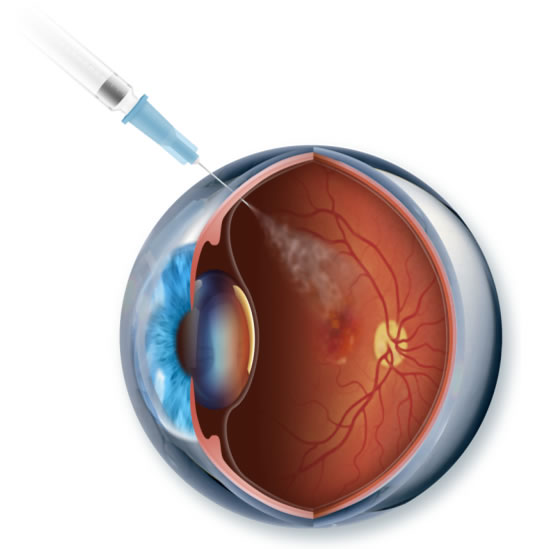AntiVEGF Therapy
What is AntiVEGF therapy used for?
AntiVEGF therapies have been used to treat retinal conditions for the last few years, revolutionising the vision and lives of many patients.
In several conditions such as; Wet AMD, Diabetic Macular Oedema, Retinal Vein Occlusion and Myopic Degeneration, there is bleeding or leaking from abnormal or damaged retinal blood vessels.
How does it work?
AntiVEGF therapies work by targeting these abnormal blood vessels, reducing or stopping the bleeding and leakage that can occur. This typically results in prevention of further loss of vision, and can also lead to improved vision.

Are there different types of AntiVEGF therapy?
There are currently 3 types of AntiVEGF therapy:
Eylea and Lucentis – this is licensed to be used in Wet AMD, Diabetic Macular Oedema, Central and Branch Retinal Vein Occlusion and Myopic CNV Degeneration.
Avastin – this is not licensed for use in the eye, but was the first type of AntiVEGF therapy to be delivered, and is the most widely used AntiVEGF agent in the USA.
The type of AntiVEGF therapy used depends on factors of the individual and their existing treatment plan. Most will require a course of 3 monthly injections with further potentially given, depending on the response to initial therapy.
How is AntiVEGF therapy given?
All AntiVEGF treatments are given as injections into the vitreous jelly of the eye and done as an outpatient procedure.
The process:
- The eye is numbed with anaesthetic eye drops.
- The skin around the eye is cleaned and a sterile drape is placed over it, then a small clip, known as a speculum, is inserted to keep the eyelids open.
- 0.05ml of AntiVEGF is injected into the eye using a small needle. (This should not be painful due to the anaesthetic administered prior)
- Antibiotic drops are applied, with the patient continuing this for the following days after.
- The whole procedure takes around 5 minutes with the injection lasting less than 20 seconds.
- Patients can generally return to normal activities straight after the procedure.

An illustration of an AntiVEGF injection being given into the eye
Are there any risks involved?
With an excellent safety profile, there is very minimal risk involved in the procedure.
Minor side effects that may occur:
Red eye – this is usually due to bleeding of tiny blood vessels on the surface of the eye and resolves by itself within a few days.
Blobs in the vision or flashing lights – this is caused by a slight disturbance of the vitreous jelly as the injection is given and normally resolves within a few hours.
Sore eye – the eye may be slightly achy for a day or two following the injection.
With anything, there are potential risks however these more serious complications occur in less than 1 in 1000 patients.
This could include:
- Serious infection in the eye
- Detached retina
- Raised eye pressure affecting vision
- Bleeding in the eye
- Inflammation in the eye
- Cataract
Important to note…
The AntiVEGF injection is not advised when:
- There is a history of allergy to a particular AntiVEGF therapy.
- A patient is trying to become pregnant, is currently pregnant or is breastfeeding.
- There is a history of heart attack or stroke in the last 3 months.

Why choose Venki Sundaram…
Highly experienced and trained at the Moorfields Eye Hospital, Venki Sundaram is a trusted Consultant Ophthalmologist who can offer quality AntiVEGF therapy. Contact us today and visit one of our clinics based in Hertfordshire.

